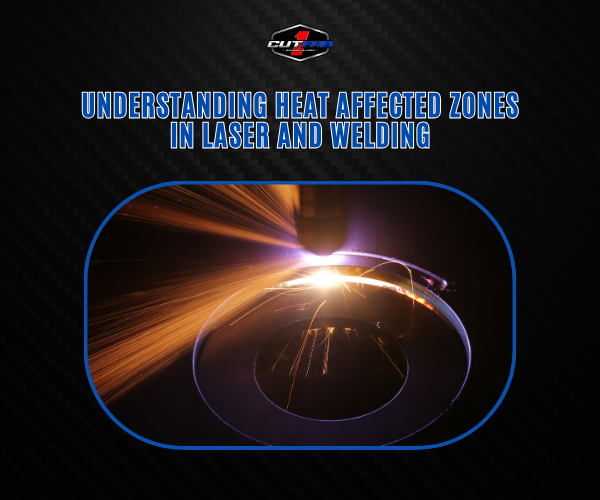
Understanding Heat Affected Zones in Laser and Welding!
In laser cutting and welding, precision isn’t just about making clean lines or perfect joints—it’s also about controlling the heat affected zone (HAZ). The HAZ is the area of metal that doesn’t melt but still undergoes structural and mechanical changes due to intense heat. Why does this matter? Because the heat affected zone in laser welding can impact strength, durability, and even the appearance of your finished part. For industries like aerospace, automotive, and medical fabrication, understanding and minimizing the HAZ is critical to ensuring consistent performance and high-quality results.
How HAZ Forms in Laser Cutting
When a laser beam strikes a workpiece, the process begins with energy absorption. Metals with high reflectivity, like aluminum, resist initial absorption, while darker or coated materials absorb energy more efficiently. Once absorbed, the concentrated laser energy rapidly heats the localized surface. This creates a steep thermal gradient, where the immediate cutting zone reaches melting or vaporization temperatures, but the surrounding material is exposed to elevated heat without fully melting. That surrounding area is what we call the heat affected zone (HAZ).
The size and severity of the HAZ largely depend on material-specific behavior. For instance, stainless steel tends to have a relatively narrow HAZ due to lower thermal conductivity, which limits heat spread. By contrast, materials like copper or aluminum—both highly conductive—dissipate heat more quickly, often creating a wider HAZ. Thickness also plays a role: thin sheets shed heat rapidly, minimizing distortion, while thicker plates retain thermal energy longer, expanding the HAZ.
In laser welding, these same principles apply. Energy density, absorption rate, and material conductivity dictate how far heat travels into the workpiece and how the microstructure changes. Understanding these mechanisms is key to reducing unwanted distortion and maintaining precision in fabrication.
Welding HAZ: Differences and Risks
While the heat affected zone (HAZ) in laser cutting is often narrow, in welding the stakes are higher because the process involves deeper heat penetration. The welding HAZ is the area adjacent to the weld bead that experiences significant thermal exposure without fully melting. This region undergoes microstructural changes as heating and cooling alter the grain structure of the metal. For example, in carbon steels, rapid heating can cause grain growth, while fast cooling may lead to the formation of brittle martensite. Both scenarios weaken the material if not carefully controlled.
Another critical risk is hardness variation within the HAZ. Different zones inside the welded joint cool at different rates, which can create hardness inconsistencies. Softer areas may reduce load-bearing capacity, while overly hard regions can become brittle and crack under stress. In industries where weld integrity is mission-critical—like shipbuilding, aerospace, or pressure vessel fabrication—even minor hardness deviations can compromise safety and performance.
Compared to laser cutting, welding introduces more extensive HAZ challenges because of prolonged heat input and slower cooling rates. That’s why welders and engineers often use techniques like preheating, controlled cooling, or post-weld heat treatment to stabilize the HAZ and reduce long-term risks.
Strategies to Minimize HAZ
Controlling the heat affected zone in laser welding and cutting isn’t about eliminating heat—it’s about managing it. By applying the right strategies, fabricators can reduce unwanted microstructural changes and preserve material integrity.
The first approach is laser parameter optimization. Power, speed, and focus determine how much energy penetrates the material. A higher cutting speed, for instance, reduces the time heat lingers on the surface, narrowing the HAZ. Likewise, adjusting beam focus ensures energy is delivered only where it’s needed. Advanced CNC systems make it possible to fine-tune these parameters for different metals and thicknesses, striking the balance between precision and performance.
Another proven method is preheating and cooling control. Preheating a workpiece before welding or cutting reduces temperature gradients, making thermal expansion more uniform. On the other hand, controlled cooling—sometimes assisted by gas shielding or water cooling—prevents rapid quenching that can cause brittleness. Together, these thermal management practices help maintain consistent hardness, minimize distortion, and extend component life.
Testing and Inspection Techniques
Even with optimized processes, the heat affected zone in laser welding must be verified to ensure reliability. That’s where testing and inspection techniques come into play. These methods not only confirm quality but also help identify risks before parts are put into service.
One common approach is the microhardness test. By measuring hardness across the weld bead, HAZ, and base metal, engineers can map out how thermal exposure has altered the material. Significant variations in hardness may reveal brittle zones, soft spots, or areas prone to fatigue failure. This quantitative data provides clear insight into whether the weld meets performance requirements.
Equally important are visual and metallurgical inspections. Visual checks detect surface defects like cracks, undercuts, or discoloration caused by overheating. Metallurgical analysis, often using microscopes or etching techniques, reveals grain structure changes within the HAZ. Together, these inspections provide a comprehensive view of both surface integrity and internal transformations—ensuring the HAZ remains stable under real-world stresses.
Conclusion
The heat affected zone in laser welding and cutting is more than just a technical detail—it’s the defining factor between precision craftsmanship and compromised quality. By understanding how the HAZ forms, what microstructural changes occur, and how hardness variations impact performance, fabricators can make informed decisions to protect material integrity.
The best practices for precision work always come down to control. Optimizing laser parameters, applying preheating or controlled cooling, and leveraging thorough inspection techniques ensure that the HAZ remains minimal and manageable. Whether it’s in aerospace, automotive, or medical device fabrication, these steps safeguard against distortion, brittleness, and structural weaknesses.
For manufacturers aiming to deliver flawless results, mastering HAZ control is not optional—it’s essential. At 1CUTFAB, we emphasize innovation and precision, ensuring every project meets the highest standards of performance. By adopting proven strategies, you can transform the challenge of HAZ into an opportunity for excellence.
